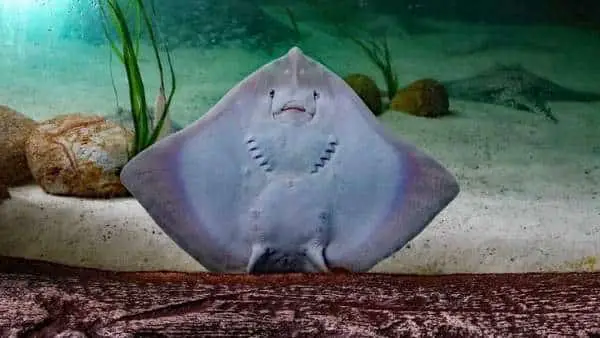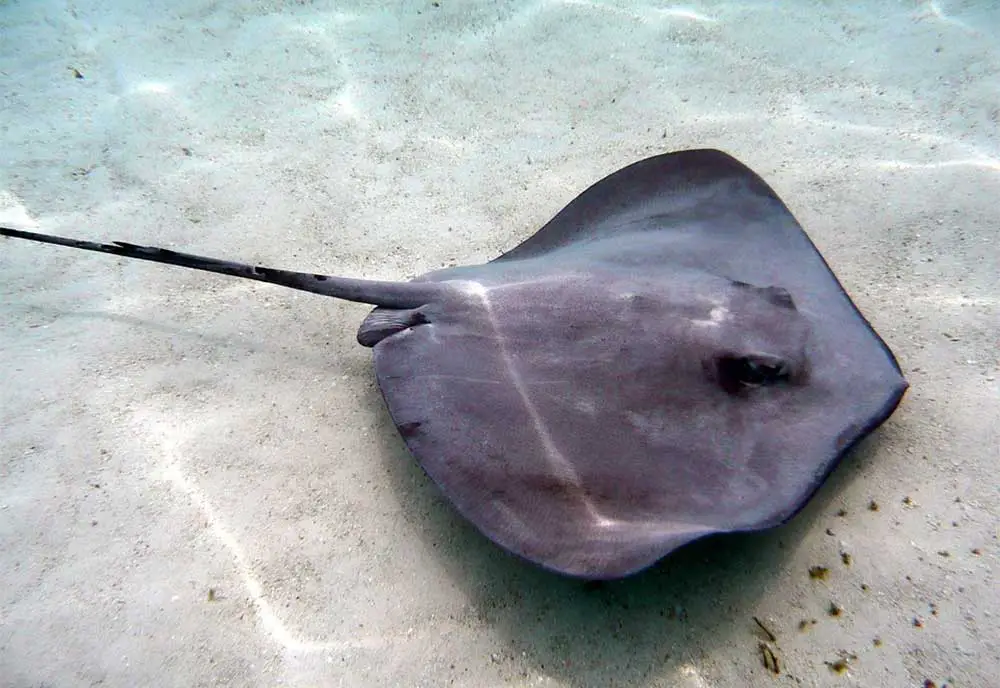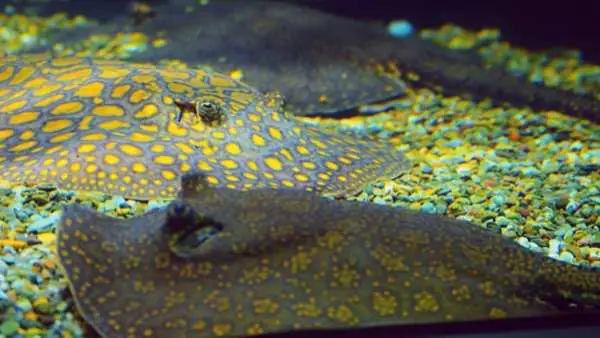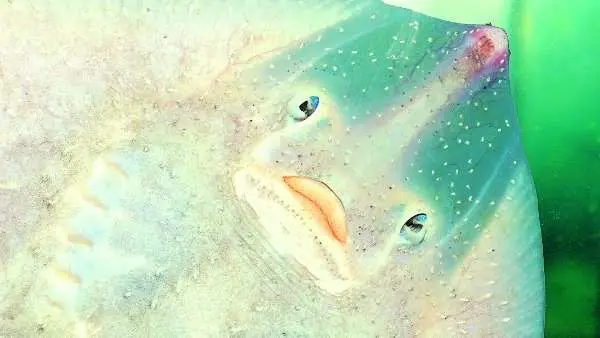If you’ve ever had the opportunity to interact with a stingray in an aquarium, it’s no mystery why these are such desired pets. Their charm is clear even through a television screen, and it’s hard not to be entranced by their loveable mixture of playfulness and elegance.
However, keeping a freshwater aquarium stingray isn’t an easy task. These creatures need a lot of space, and they can be sensitive to water fluctuations.

Not every aquarium tank is suitable for a stingray, and not every home has the space for one. If you’re interested in getting a freshwater aquarium stingray, then you need to put the effort in.
Once you’ve made a suitable home, a stingray can be an incredibly rewarding pet and companion. Even though, yes, they do sting. Below, we go into the details you need to know before purchasing a stingray. Stingrays need some extra care, but it’s always worth doing it right.
What are freshwater aquarium stingrays?
You probably already have a pretty good idea of what a stingray looks like. With a wide, floppy disc shape, the stingray has sometimes been referred to as the ‘sea pancake’. Freshwater stingrays tend to be smaller than their marine counterparts.
Therefore, you might be shocked to know that stingrays are actually a relative of sharks. As well as being carnivorous, stingrays have a few things in common with their terrifying cousins.
Stingrays, like sharks, have cartilaginous skeletons, rather than traditional bones. This skeleton makes them fairly flexible, perfect for bottom feeding.
Like sharks, they also have Ampullae of Lorenzini. This strange sounding ability refers to electroreceptors, which allow the stingrays to sense the electric field of other fishes. Perfect for hunting in the dark.
Of course, the most notable feature of the stingray is the venomous barb that gives them their name.
Where do freshwater stingrays come from?
Many species of stingray are marine, meaning they live at sea. They tend to prefer shallow waters, and like to move with the tide.
Freshwater stingrays prefer less salty waters, and can be found in rivers across Australia, Africa, and Southeast Asia. However, the majority seen for sale in the US come from South America. These are from the family Potamotrygonidae.
Different genus of stingray can be found in river systems across the Amazon, and South America. They like a slow-moving, sandy-bottom river, but can head into forests when they become flooded.
While in the past the majority of aquarium stingrays were wild-caught, more and more are being bred. Stingrays that have been bred have a better chance of surviving (and thriving) in captivity.
The basics of freshwater stingray
Size
Some species of wild freshwater stingray have been rumored to achieve sizes several feet wide. These are obviously not suitable for any home aquariums. Even the smallest of freshwater aquarium stingrays can still get pretty big.
A stingray can reach a size of up to 36 inches, although the majority will be smaller. You can expect a stingray to grow to a diameter of 24 inches. When given plentiful food, it isn’t unusual for them to exceed this.
There are smaller genus of stingray available, but it’s better to be over prepared. Stingrays need ample space to move around. As you continue to care for them, they will continue to grow.
Sexing
It’s pretty easy to tell a male and female stingray apart, even for a novice. These visible signs are easier to spot once a stingray has reached sexual maturity, but it’s still possible to tell on a pup.
The primary thing to look for is claspers. These two specialized fins are located at the base of the tail. The claspers are short and stubby, and easy to spot in a sexually mature male. A male stingray has similar coloring to a female, but is often smaller.
The easiest way to know if you have a female is that they don’t have claspers. Other than that, females are generally larger, and have a thicker skin.
Behavior
Although some may choose to raise stingray for their unusual looks, the best reason for owning stingray is their fun personalities,
Stingrays are intelligent and inquisitive. You might find them watching what you do, interacting as you go about your day, and trying to get involved. A good owner who has bonded with their stingray may even be able to pet them, and a stingray can be taught to hand feed.
However, don’t expect them to be constantly playing, as stingrays also enjoy spending their time burrowing into the substrate. A stingray may spend part of the day buried in sand, with nothing visible but the eyes.
Stingrays are very unlikely to become aggressive unless provoked, but they can be boisterous. If you have several in a tank, feeding time can get messy.
The time you’re most likely to see aggression is when a male is breeding.
Diet
Stingrays are carnivorous, and feast on smaller fishes. For this reason, they’re often best kept in a tank alone. In the wild, a stingray will chomp opportunistically on little fishes, but mostly prey on the crustaceans found on the river floor.
In a tank, stingrays should be fed meaty offerings. They can eat live food, which is enticing for young stingrays, or those which have stopped eating. Most owners prefer to feed them pieces of chopped up fish.
Stingrays have big appetites, so they need to be fed regularly.
Choosing the right stingray
There are several types of stingray that are found in the aquarium trade. The most common species are from South America, and are known as Potamotrygon. When choosing a stingray, there are several things to look out for, and things to avoid. Always use a trusted breeder, to ensure the health of your stingray.
Potamotrygon Motoro
The Potamotrygon Motoro - otherwise known as the Motoro or Ocellate stingray - is one of the most popular types in the aquarium trade. Although they can get quite large - over 26 inches is normal - their attractive markings and lower sensitivity make them a good choice for first time owners.
A Motoro stingray can be identified by the dark brown color and spots across the body. These spots are normally yellow or orange, and can be very distinctive.
Potamotrygon Hystrix
The Hystrix may lack some distinctive patterning found on other stingrays, but it is still a beautiful creature. This is a particularly good choice for anyone buying a first stingray, as they don’t grow to the same size as other options.
They’re also pretty hardy, and aren’t as sensitive to water fluctuations. However, they still need a great deal of care and attention. While they may not get as big, a well cared for Hystrix can be expected to grow to around 15 inches. Some have even reached the size of 20 inches.
Potamotrygon Orbignyi
The Orbignyi - or reticulated - stingray, is occasionally described as a “teacup” stingray. This is because it only tends to grow to around 15 inches in size. Many consider these to be the best option for first time owners.
They also adapt well to different water conditions, although fluctuations should still be avoided.
It’s important to take care when purchasing something labelled as a “teacup ray”, because inexperienced dealers occasionally use this to describe any young stingray.
What you bought, thinking it was an Orbignyi, actually then grows into a 30-inch ray. Always do your research before buying, and don’t be afraid to ask questions.
Potamotrygon Henlei
Another popular choice, the Henlei has an incredibly attractive appeal - and a price tag to match. This species can only be bred, as it’s no longer legal to import. However, as they’re so popular among hobbyists, they can be found on the market.
What makes these stingrays so beautiful is the contrast between the dark base color and the bright spots on top. Sometimes referred to as the “polka dot stingray”, these really are a sight to see.
The spots aren’t uniform, and some stingrays will have many, while others have only a few. The Henlei can also be identified by the spots that are found on the underside. This is another large species, and can grow up to 24 inches in diameter.
Potamotrygon Leopoldi

This much desired stingray is sadly rare now, due to regulations in trading. They are still bred, but will often be expensive to purchase. The Leopoldi is sensitive to different water conditions. This, combined with the high price, makes them only a choice for experienced owners.
It isn't difficult to see what makes these stingrays so desired. The jet black base allows the white spots of the Leopoldi to really jump out. Unlike the Henlei, the spots of the Leopoldi are a clear and bold white. There is a stunning variety across the genus, with certain diamond and “eclipse” patterning being particularly sought after.
What to avoid when choosing a stingray
When choosing a stingray, you want a healthy and happy companion. They should look well-fed, with none of the cartilage showing through the skin. If you can, ask to observe the stingrays as they feed. A healthy stingray has a voracious appetite. The only time it’s normal for them to eat less is when they’re introduced to a new environment.
Avoid stingrays that are showing signs of “death curl”. This is when the outer edges of the stingray curl upwards. While a ripple is natural in a swimming stingray, a Death Curl is a lasting, chronic curl. This is a sign of a stingray that’s been kept in poor conditions, and recovery is unlikely.
Never buy stingrays known as “bat rays”. These are becoming increasingly common, and it’s actually a genetic defect. This is when part of the disc is missing around the head. Unscrupulous breeders may even cut a young stingray to encourage this look.
While hybridized stingrays are available, these should also be avoided. Many genus of stingray are protected, and hybridization is causing them to die out.
Be aware that it is illegal to own a stingray in some states. In Arizona, Arkansas, California, Georgia, Hawaii, Mississippi, Nevada, Oklahoma, Texas, and Utah, you cannot own a stingray. This is because if they get into natural waters, they can breed and thrive, decimating the local fish population. In Florida and Colorado, a permit is required.
Caring for your freshwater stingray
Although they may be rewarding, freshwater stingrays aren’t the easiest of fish to care for. If you intend to keep them, you have to be prepared for the financial sacrifice, as well as the space a stingray needs.

Aquarium Size
The most important factor of the aquarium is the floor space, which can make them tricky to buy. A stingray needs at least 5 times the disc diameter in length to be able to comfortably move around. Around 6 feet by 3 feet should be suitable for one or two stingrays.
The height of the tank is much less important, as they are bottom dwellers. 2 feet should be enough.
All considered, the minimum size of a tank for a stingray is roughly 200 gallons. However, make sure that most of that size is from length, rather than height. A stingray needs room to move and turn.
Remember, as well as making a stingray happy, a larger tank is better for you. In a large tank, your ray can really move around and explore, and you can enjoy watching them!
Decoration and substrate
Stingrays don’t need much in the way of decoration, but a substrate is preferred.
A size zero river sand or other fine gravel is the ideal substrate. This allows the stingray to burrow, which is something they often do in the wild.
Burrowing is something that stingrays do for security, and they find particular comfort in it when stressed. Without anything to burrow in, a stingray can end up feeling exposed.
Some owners choose to have a bare bottom tank. This does have the advantage of making cleaning much easier. However, the excess of light bouncing off the glass can be upsetting for a stingray.
Both options are acceptable, and stingrays can live a healthy and happy life with or without substrate. However, we prefer the look and benefits of adding a substrate.
Decorations, on the other hand, can be a nuisance. Stingrays need space to move, so large logs pose problems in smaller tanks. There’s also no point in getting rooted plants. The stingray will simply dig underneath, uprooting them.
If you want to add some decoration, look for smooth rocks and Brazilian driftwood. Floating plants are also a nice addition. Be careful not to overdo it. What stingrays like best is unimpeded floor space.
Filtering and equipment
Stingrays demand quality water. They will not be happy if you don’t take care of their water supply. Unfortunately, stingrays also create a lot of waste. It’s an owner's responsibility to ensure the water in a stingray tank is up to standard, even if the rays themselves aren’t doing much to help.
Stingrays produce a large amount of ammonia, the most of any freshwater fish of their size. This is necessary to balance their adaptation to freshwater. They also produce loose feces that fall apart easily.
Stingrays are incredibly sensitive to ammonia, nitrate, and nitrites. These levels should be kept at 0ppm, and a robust filtration system is a must.
The water turnover rate should be kept higher than usual. It must cycle at least 8 times the volume of the tank per hour, but 15 times or higher is preferable.
The use of a sump is recommended. As well as increasing the water volume and filter media, a sump system can incorporate a heater.
If you don’t have a sump, be sure to install a heater guard. Stingrays can burn easily when kept in a tank with a standard heater.

Before you introduce the stingrays to the tank, the water needs to be fully cycled. What stingrays hate more than anything is fluctuations.
When designing your tank system, care and attention must be paid to the filtration system. This is one of the most important things you can do. Stingrays aren’t receptive to change, so you want to get his sorted before you introduce them to their new home.
Water Chemistry
One of the reasons stingrays are known as difficult pets is due to the issues they have with water conditions. They can adapt to suit a reasonable range, especially hardy types like the Hystrix, but what they need most is consistency.
Stingrays prefer slightly acidic water, with a pH of 6.5 to 7.0, and a hardness of 5-10°dH. Stingrays bred locally will find it easier to adapt to the water in your area. Again, keeping the pH consistent is what matters most.
Stingrays enjoy warmer temperatures, so try and keep the tank around 75℉ to 80℉. When using a tank heater, always keep a heat guard around it. Otherwise, an inquisitive stingray risks burning itself.
Stingrays are sensitive to ammonia, nitrite, and nitrates, so keep the levels as close to zero as possible.
Changing the water regularly is important. Small (10%) changes, done often, are best as they keep the water consistent.
Tank mates
Stingrays are carnivorous, so there are certain tank mates that should be avoided. You may think you’re adding little fish as friends, but the stingrays will assume that this is dinner.
Companionship isn’t necessary, and most stingrays will be quite happy kept on their own. However, species such as Severums, Silver Dollars, Arowanas, and Bichirs have all been found to be suitable companions.
If you want to add some tank mates, look for fish that are middle to upper level swimmers. This leaves the bottom space free for the stingrays. The fish also need to be placid, as aggressive species have been known to bully stingrays.
Suckermouth catfish and similar species must be avoided. These have been known to suck onto the stingray and cause serious damage.
Stingrays can live with other rays, but they’re perfectly happy on their own. Groups of males can be boisterous, even aggressive, so it’s better to have groups of females. If you do choose to own several stingrays, extra care needs to be taken when feeding.
Feeding your stingray
Stingrays love to eat, and they have a big, carnivorous appetite. If you want to own stingrays, be prepared to pay out for food.
In the wild, stingrays will often eat mollusks, crustaceans, and other bottom dwellers. In your home, there are a few different options for what to feed them. White fish such as tilapia is a good choice, as are frozen bloodworms, earthworms, and shrimp.
Stingrays have small mouths, so any food should be chopped into bite size pieces. Despite this, they are excellent at chewing and digesting. Heads and shells can be left on any shrimp, as a stingray can chew right through it.
Stingray can be given live food, although this is less common. Live food, such as earthworms, is recommended for young or new stingrays. The moving prey is more appealing, and encourages them to eat. When you first introduce a stingray to the tank, live food is used to acclimatize them and get them eating.
Stingrays can also eat specially formulated sinking pellets. These are becoming more popular, and there are several brands on the market.
Once stingrays are comfortable in their home, dinner time can become a rowdy occasion. They’re liable to thrash about, so be careful to watch out for the stinger. For groups of stingrays, you may wish to use tongs to ensure each one is fed equally.
Stingrays need to be fed several times a day. Three times is ideal, and they should be given only as much food as they can eat in 5 minutes. Be sure to clean up after them, to prevent food decaying.
Once the stingray is comfortable, feeding time should become a delight. They can even be taught to eat from your hand!
Stingray barbs
Stingrays have the name for a reason, and it isn’t hard to see why. While stingrays are generally non-aggressive, you must always be aware of the barb. Especially on a particularly large species. They can thrash about, and you don’t want to be caught unawares by a stinger.
The venom of a stingray can be dangerous, but it’s unlikely to be fatal, especially as it’s normally the extremities that are stung. However, if you do find yourself stung, rinse the wound in hot water and contact a doctor. They can treat the pain, and ensure the wound is clear. If the barb is embedded in the skin, don’t try to remove and instead seek medical help.
Stingrays do shed their barbs, and they do so roughly every six months. When this happens, the barb is still dangerous, so you must exercise caution. Wear heavy-duty gloves, and remove the barb from the tank. If left in, stingrays risk damaging themselves.
Breeding stingrays
With the import of many types of stingray being prevented, breeding stingrays is becoming more and more popular. It’s actually relatively easy to accomplish, although it does require care and attention.
Although you might assume stingrays lay eggs, they actually give birth to live young! Stingray pups look a lot like the adult version, only smaller. It’s no surprise that breeding stingrays is becoming increasingly popular, because these little creatures are a delight.
As an owner, there isn’t much you can do to encourage breeding other than keeping the stingrays healthy. A well-fed, happy stingray is more likely to reproduce than those in poor conditions.
Breeding stingrays take time, as it can be anywhere between 8 months and 2 years before a stingray reaches sexual maturity. Male stingrays tend to get there faster, where females need a little more time.
When placed in a tank together, and given access to plentiful food, a male stingray will likely try to breed the female. However, they can be picky, and there’s no guarantee of interest. If a male does attempt to breed, he can become aggressive.
The male will chase the female around the tank, and try to bite at her disk. For this reason, it’s important to ensure the female is larger than the male, so she can fend him off.
Keep a close eye on the mating ritual. If the male is repeatedly refused, things can get violent. Prepare to separate the two if this happens.
If a mating is successful, the stingrays will position themselves belly to belly. The male will inseminate the female using his clasper. The process occurs internally, and should take no more than a minute. If the mating is successful, the male loses interest.
Gestation and birth
It can be difficult to tell if the female is pregnant, but she may start to show swelling. Especially near the end of gestation, it may even be possible to see motion underneath her skin.
A pregnant female will have an even bigger appetite than usual, so make sure to provide her with lots of food.
The gestation period usually lasts around 3 months, although there is variation.
When the female is ready to give birth, it often happens at night or in the early morning. In the wild, this would reduce the risk from predators. There isn’t much you can do to help, and the pups should come out when they’re ready.
A female can give birth to a litter of between 1 and 8 pups. They young will look very much like smaller versions of their parents.
Females should only be bred roughly twice a year. Breeding too often can lead to stress and ill health.

Rearing stingray pups
Many breeders prefer to remove the pups as soon as they’re born. If they’re alone in the tank with the mother, cannibalism is unlikely. However, the risk increases the more stingrays there are around.
When initially born, the pups will have a yolk sac that provides them with nutrients. This will last them a few days, but it’s best to offer live food immediately. Pups will often be uninterested in dead food, and live food encourages them to start eating. Eventually, dead food can be mixed in with the live, before replacing it completely.
Rearing pups is very similar to caring for adults. Feed them three times a day, keep the water consistent, and give them space to grow.
Final Thoughts
Stingrays are curious, playful, and endless fun to watch. While they may have some very specific needs, the reward is more than worth the effort.
If you’re a first time buyer interested in stingrays, then do your research! Be prepared for the time and financial burden they may be.
In turn, you get a loveable companion, who provides hours of entertainment.

